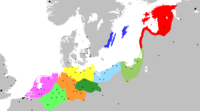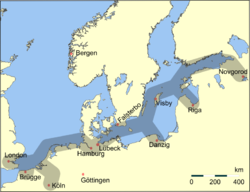Stralsund
| Stralsund | |
 |
|
 |
|
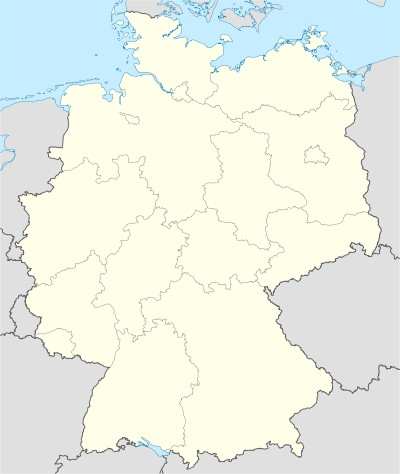 Stralsund
|
|
| Coordinates | |
| Administration | |
| Country | Germany |
|---|---|
| State | Mecklenburg-Vorpommern |
| District | Urban district |
| Lord Mayor | Alexander Badrow (CDU) |
| Basic statistics | |
| Area | 38.97 km2 (15.05 sq mi) |
| Elevation | 13 m (43 ft) |
| Population | 57,778 (31 December 2009)[1] |
| - Density | 1,483 /km2 (3,840 /sq mi) |
| Founded | 1234 |
| Other information | |
| Time zone | CET/CEST (UTC+1/+2) |
| Licence plate | HST |
| Postal codes | 18435, 18437, 18439 |
| Area code | 03831 |
| Website | www.stralsund.de |
Stralsund (German pronunciation: [ˈʃtʁaːlzʊnt]) is a city in Mecklenburg-Vorpommern, Germany, situated at the southern coast of the Strelasund (a sound of the Baltic Sea separating the island of Rügen from the mainland).[2] Two bridges (the Rügendamm and since October 2007 the new Rügen bridge) and several ferry services connect Stralsund with the ports of Rügen.[2]
The main industries of Stralsund are shipyards, fishing, and, to an increasing degree, tourism.
Contents |
History
In medieval ages, the Stralsund area was part of the West Slavic Principality of Rügen, which was part of the Kingdom of Denmark since 1168. At that time, the Dänholm isle and a small fishing village, both at the site of the latter city, were named Strale / Stralow, meaning "arrow" (this meaning is still preserved in the town's coat of arms, showing an arrow).
In the course of German Ostsiedlung, many German settlers, gentry and merchants were called into the principality, and eventually populated the Strale site. Merchants from other countries as well as locals were attracted to the settlement and made up for one third of the city's population. The Danish navy was using the isle as well. When the settlement had grown to town size, prince Wizlaw I of Rügen granted Lübeck law to "our town Stralow" in 1234. In 1240, when the prince gave additional land to the city, he called it Stralesund.
The success of the settlement challenged the powerful Free City of Lübeck, which burnt Stralsund down in 1249. Afterwards the town was rebuilt with a massive city wall having 11 town gates and 30 watchtowers. The Neustadt, a town-like suburb, was merged to Stralsund by 1361. Schadegard, a twin town to Stralsund also founded by Wizlaw I nearby, but was not granted German law, served as the principal stronghold and enclosed a fort. It was given up and torn down by 1269 under the pressure of the Stralsund Bürger.
In 1293 Stralsund became a member of the Hanseatic League.[2] A total of 300 ships flying the flag of Stralsund cruised the Baltic Sea in the 14th century. In 1325, the Principality of Rügen became part of the Duchy of Pomerania, Stralsund however maintained a considerable independence.
In the 17th century, Stralsund became a theatre in the Thirty Years' War. In the Battle of Stralsund (1628), the town was besieged by Albrecht von Wallenstein after the council refused to accept the Capitulation of Franzburg..[3] Stralsund resisted with Danish and Swedish support.[3] The Swedish garrison in Stralsund was the first on German soil in history.[3] With the Treaty of Stettin (1630), the town became one of two major Swedish forts in the Duchy of Pomerania, besides Stettin (now Szczecin).[4]
After the war, the Peace of Westphalia (1648) and the Treaty of Stettin (1653) made Stralsund part of Swedish Pomerania. Lost to Brandenburg in the Battle of Stralsund (1678), it was restored to Sweden in the Treaty of Saint-Germain-en-Laye (1679). In the Great Northern War in 1715 Charles XII led the defence of Stralsund for a year against the united European armies. Stralsund remained under Swedish control until the Battle of Stralsund (1807), when it was seized by Napoleon Bonaparte's army. Seized by Ferdinand von Schill's freikorps in 1809, it was subsequently re-gained by France, with Schill killed in action. In the Congress of Vienna (1815), Stralsund became a part of the Prussian Province of Pomerania and the seat of a government region resembling the former Swedish Pomerania.
From 1949 until German Reunification in 1990, Stralsund was part of the German Democratic Republic.
| Historic Centres of Stralsund and Wismar* | |
|---|---|
| UNESCO World Heritage Site | |
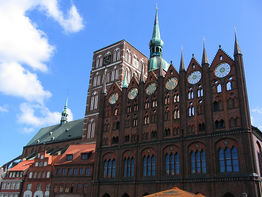 |
|
| State Party | |
| Type | Cultural |
| Criteria | ii, iv |
| Reference | 1067 |
| Region** | Europe and North America |
| Inscription history | |
| Inscription | 2002 (26th Session) |
| * Name as inscribed on World Heritage List. ** Region as classified by UNESCO. |
|
Main sights
- The Brick Gothic historic centre is a UNESCO World Heritage Site.
- The heart of the old town is the Old Market Square (Alter Markt), with the Gothic Town Hall (13th century). Behind the town hall stands the imposing Nikolaikirche (St. Nicholas' Church), built in 1270-1360. The square is surrounded by houses from different periods, including the Gothic Wulflamhaus (a 14th-century patrician house, today a restaurant), and the Baroque Commandantenhaus, seat of the old Swedish command headquarters.
- The Jakobikirche (Saint James's Church), built in mid-14th century. It was destroyed several times, e.g. by Wallenstein and in World War II.
- The Marienkirche (Saint Mary's Church), built in 1383-1473 in Gothic style, is the largest church in Stralsund, and from 1625—1647 it was the world's tallest structure. Its octagonal tower (104 meters high) offers a magnificent view of Stralsund and the neighboring islands of Rügen and Hiddensee.
- The Katharinenkloster (Monastery of Saint Catherine), built in the 15th century, houses two museums: a museum of history, and an oceanography museum. The ancient refectory of the monastery is one of the most spectacular Gothic interiors in Germany.[1],[2],[3]
- The Johanniskloster (Franciscan monastery, 1254), is one of the oldest buildings in the town.[4]
- Stralsund is the port of registry for the former German Reichsmarine Navy Sail Training ship "Gorch Fock" 1. It is now a floating Museum
- Stralsund has several museums dedicated to marine life and human interaction with the sea. The biggest ones are the German Oceanographic Museum and the new Ozeaneum. There is also a Nautineum. There is also the Marine Museum containing the history of the Germany Navy. It is located on Dänholm Island a former historic Navy Base. This museum houses one of the last remaining DDR Volksmarine torpedo boats.
Transport
Stralsund is linked to the A20 motorway (towards Berlin and Hamburg), via the B96n dual-carriageway. Other major roads include the B105 (beginning in the town centre and continuing to Rostock) and the B96 (major road to Rügen) and the B194 to Grimmen.
When travelling by air, passengers usually do so via Rostock Laage Airport with connecting flights from Munich.
City buses are run by SWS (Stadtwerke Stralsund).
International Relations
Twin towns and sister cities
Stralsund is twinned with:
Gallery
 Stralsund as seen from the seaside. |
 Founding document from 1234. |
 Marienkirche (St. Mary's church). |
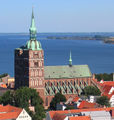 Nikolaikirche (St. Nicolas's church). |
Notable residents
- Ernst Moritz Arndt (1769 - 1860)
- Adolf Heinrich Graf von Arnim-Boitzenburg (1803 - 1868)
- Hermann Burmeister (1807 - 1892)
- Joachim Nicolas Eggert (1779 - 1813)
- Wilhelm Ferdinand Erichson (1809 - 1848)
- Hans Henrik von Essen (1755 - 1824)
- Jürgen Heuser (b. 1953)
- Eduard von Jachmann (1822 - 1887)
- Gustav Karl Wilhelm Hermann Karsten (1817 - 1908)
- Harry Kupfer (b. 1935)
- William Lindley (1808 - 1900)
- Helmut Losch (1947 - 2005)
- Ulrike Maisch (b. 1977)
- Hermann von Mallinckrodt (1821 - 1874)
- Angela Merkel (b. 1954), politician, Her office is still located on the main shopping street
- Silke Möller (b. 1960)
- Arnold Ruge (1802 - 1880)
- Carl Wilhelm Scheele (1742 - 1786)
- Ferdinand von Schill (1776 - 1809)
- Georg Friedrich Schömann (1793 - 1879)
- Gisela Peschke (1942-1993), Artist
- Friedrich Spielhagen (1829 - 1911), writer
- Leonhard Tietz(1849 - 1914), merchant
- Christian Ehrenfried Weigel (1748 - 1831)
- Georg Wertheim(1857 - 1939), merchant
See also
- Stralsunder Highflier
Sources
Footnotes
- ↑ "Bevölkerungsentwicklung der Kreise und Gemeinden" (in German). Statistisches Amt Mecklenburg-Vorpommern. 31 December 2009. http://service.mvnet.de/statmv/daten_stam_berichte/e-bibointerth01/bevoelkerung--haushalte--familien--flaeche/a-i__/a123__/2009/daten/a123-2009-22.pdf.
- ↑ 2.0 2.1 2.2 Britannica Online Encyclopedia, "Stralsund" (city), 2007, webpage: EB-Stralsund.
- ↑ 3.0 3.1 3.2 Langer, Herbert (2003). "Die Anfänge des Garnisionswesens in Pommern". In Asmus, Ivo; Droste, Heiko; Olesen, Jens E. (in German). Gemeinsame Bekannte: Schweden und Deutschland in der Frühen Neuzeit. Berlin-Hamburg-Münster: LIT Verlag. pp. 402–403. ISBN 3825871509. http://www.google.de/books?id=nI9dItT816kC&pg=PA397.
- ↑ Langer, Herbert (2003). "Die Anfänge des Garnisionswesens in Pommern". In Asmus, Ivo; Droste, Heiko; Olesen, Jens E. (in German). Gemeinsame Bekannte: Schweden und Deutschland in der Frühen Neuzeit. Berlin-Hamburg-Münster: LIT Verlag. p. 397. ISBN 3825871509. http://www.google.de/books?id=nI9dItT816kC&pg=PA397.
- ↑ "Malmö stads vänortssamarbete" (in Swedish). © 2004-2009 Malmö stad, 205 80 Malmö, Organisationsnummer: 212000-1124. http://www.malmo.se/faktaommalmopolitik/internationelltsamarbete/vanortssamarbetet.4.33aee30d103b8f15916800032874.html. Retrieved 2009-06-27.
Further reference
- Britannica Online Encyclopedia, "Stralsund" (city), 2007, webpage: EB-Stralsund.
External links
- Satellite picture by Google Maps
- Travel article about Stralsund from Expatica.com
- Stralsund World Heritage
- The "Stralsund Expedition" of 1715, depicted in Thomas Carlyle's "History Of Friedrich II of Prussia"
|
||||||||||
|
||||||||||||||||||||
|
||||||||||||||||||||||||||
|
||||||||||||||||||||||||||||||||||||||||||||
|
|||||||||||||||||||||||||||||||||||||||||||||||||||||||||||||||
